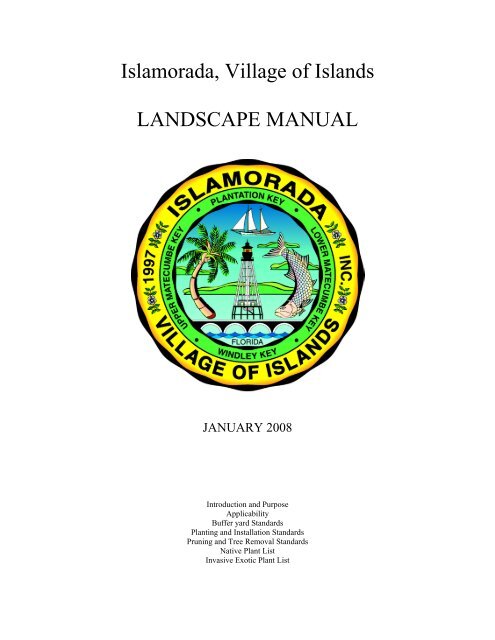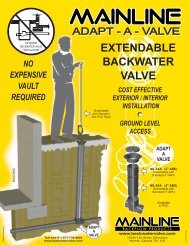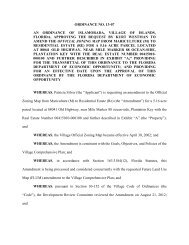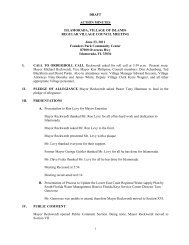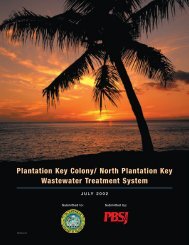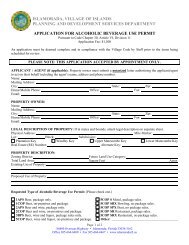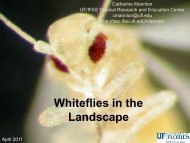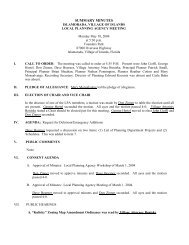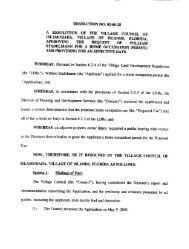Islamorada, Village of Islands LANDSCAPE MANUAL
Islamorada, Village of Islands LANDSCAPE MANUAL
Islamorada, Village of Islands LANDSCAPE MANUAL
You also want an ePaper? Increase the reach of your titles
YUMPU automatically turns print PDFs into web optimized ePapers that Google loves.
<strong>Islamorada</strong>, <strong>Village</strong> <strong>of</strong> <strong>Islands</strong><br />
<strong>LANDSCAPE</strong> <strong>MANUAL</strong><br />
JANUARY 2008<br />
Introduction and Purpose<br />
Applicability<br />
Buffer yard Standards<br />
Planting and Installation Standards<br />
Pruning and Tree Removal Standards<br />
Native Plant List<br />
Invasive Exotic Plant List
TABLE OF CONTENTS<br />
TABLE OF CONTENTS .............................................................................................................................................. 2<br />
INTRODUCTION AND PURPOSE ............................................................................................................................. 3<br />
Why was this landscaping manual created? ............................................................................................................... 3<br />
Why are buffers and landscaping important? ............................................................................................................ 3<br />
APPLICABILITY ......................................................................................................................................................... 3<br />
When are you required to install landscaping? .......................................................................................................... 3<br />
For new development on vacant parcels: ................................................................................................................... 3<br />
For existing development: ......................................................................................................................................... 3<br />
What if I cannot fully accommodate the required buffer? ......................................................................................... 4<br />
What maintenance is required and who is responsible? ............................................................................................ 4<br />
INVASIVE EXOTIC VEGETATION .......................................................................................................................... 4<br />
What is invasive exotic vegetation? ........................................................................................................................... 4<br />
When are you required to remove invasive exotic vegetation? ................................................................................. 4<br />
Is a permit required to remove invasive exotic vegetation? ....................................................................................... 5<br />
CALCULATION OF BUFFER REQUIREMENTS ..................................................................................................... 5<br />
How do I calculate what is required for my buffer? .................................................................................................. 5<br />
What if I am required to plant more than one buffer? ............................................................................................... 5<br />
What if my required buffer is located along a canal? ................................................................................................ 5<br />
What if I am required to install a Class E or F buffer? .............................................................................................. 5<br />
What if I have existing vegetation on my property? .................................................................................................. 5<br />
BUFFER YARD STANDARDS ................................................................................................................................... 6<br />
Class A Buffers .......................................................................................................................................................... 6<br />
Class B Buffers .......................................................................................................................................................... 7<br />
Class C Buffers .......................................................................................................................................................... 7<br />
Class D Buffers .......................................................................................................................................................... 8<br />
Class E Buffers .......................................................................................................................................................... 8<br />
Class F Buffers .......................................................................................................................................................... 9<br />
Class G Buffers .......................................................................................................................................................... 9<br />
Scenic Corridor And Major Street Buffer Yards ..................................................................................................... 10<br />
Zoning District Boundary Buffer Yards .................................................................................................................. 10<br />
Street Trees .............................................................................................................................................................. 11<br />
Drain Fields ............................................................................................................................................................. 11<br />
Berms and Swales .................................................................................................................................................... 11<br />
MATERIALS AND INSTALLATION CRITERIA FOR REQUIRED LANDSCAPING ......................................... 11<br />
What do I need to consider when choosing the location <strong>of</strong> plants within my required buffer? ............................... 11<br />
What do I need to do while planting in order to help ensure the survival <strong>of</strong> the vegetation? .................................. 11<br />
What are the minimum size plants that I can use? ................................................................................................... 11<br />
Do I have to use native vegetation? ......................................................................................................................... 12<br />
Can I use the same species for all <strong>of</strong> my required trees? ......................................................................................... 12<br />
PRUNING AND TREE REMOVAL STANDARDS ................................................................................................. 12<br />
Is a permit required for minor pruning or the removal <strong>of</strong> dead portions <strong>of</strong> a tree, such as palm fronds? ................ 12<br />
Is a permit required for major pruning or tree removal? .......................................................................................... 12<br />
Are there any standards that must be met when pruning trees? ............................................................................... 13<br />
PLANT LISTS AND NOMENCLATURE ................................................................................................................. 14<br />
Canopy Trees ........................................................................................................................................................... 14<br />
Understory Trees ..................................................................................................................................................... 15<br />
Shrubs (Including Palms) ........................................................................................................................................ 17<br />
Ground Covers ....................................................................................................................................................... 188<br />
Vines ........................................................................................................................................................................ 19<br />
Breakaway Vegetation ............................................................................................................................................. 20<br />
Invasive Exotic Vegetation ...................................................................................................................................... 21<br />
2
INTRODUCTION AND PURPOSE<br />
Why was this landscaping manual created?<br />
This manual has been prepared to accompany the landscaping regulations <strong>of</strong> the <strong>Islamorada</strong>, <strong>Village</strong> <strong>of</strong> <strong>Islands</strong><br />
(<strong>Village</strong>) pursuant to Article VII, Division 4 <strong>of</strong> the <strong>Village</strong> Land Development Regulations (LDR). The purpose <strong>of</strong><br />
this manual is to provide standards and guidelines for the installation and maintenance <strong>of</strong> required landscaping, to<br />
preserve and maintain natural vegetation and habitat.<br />
Why are buffers and landscaping important?<br />
The benefits <strong>of</strong> landscaping are numerous. Landscaping reduces stormwater run<strong>of</strong>f, reduces water consumption,<br />
conserves energy, decreases ambient temperatures, and enhances the value and aesthetic appearance <strong>of</strong> property.<br />
The installation <strong>of</strong> landscaping and the preservation <strong>of</strong> native vegetation are integral to the prevention <strong>of</strong> water and<br />
air pollution. The root systems <strong>of</strong> trees hold and consolidate soil and other loose earthen materials, thereby helping<br />
to prevent erosion, reducing non-point-source water pollution and maintaining the continued vitality <strong>of</strong> natural<br />
habitats for the propagation and protection <strong>of</strong> wildlife, birds, game, fish and other aquatic life. Removal <strong>of</strong> trees<br />
increases surface run<strong>of</strong>f, which contributes to water pollution. Trees, especially larger, older trees, are a valuable<br />
amenity to the urban environment providing historical, physical, aesthetic and physiological benefits. Plant materials<br />
moderate the effects <strong>of</strong> cold and heat by providing shade and protection from the wind, reduce glare and noise<br />
levels, and <strong>of</strong>fer a haven for birds and animals. The preservation <strong>of</strong> existing vegetation, the selection <strong>of</strong> appropriate<br />
native site suitable plant materials, the removal <strong>of</strong> invasive exotic vegetation, and appropriate maintenance can<br />
achieve water conservation.<br />
APPLICABILITY<br />
When are you required to install landscaping?<br />
In general, landscaping requirements apply to all development for which a complete application for site plan<br />
(building permit) is required. All required landscaping must be shown on a site plan submitted for a proposed<br />
development. Existing native vegetation takes priority and may be counted towards any requirement and should be<br />
indicated on the submitted plan.<br />
For new development on vacant parcels:<br />
All required land use, street and scenic corridor buffer yards shall be installed and maintained as part <strong>of</strong> the<br />
proposed development. These buffers are as follows:<br />
Street Buffer: Properties fronting U.S. 1, SR 905 or Old Highway shall install the required street buffer<br />
yard.<br />
Scenic Corridor Buffer: Properties fronting U.S. 1, SR 905 or Old Highway designated as hammock,<br />
saltmarsh, or wetlands and is vegetated with plants native to the Florida Keys shall install a scenic corridor<br />
buffer yard<br />
Land Use Buffer: Properties with a boundary between two (2) zoning districts shall install the required<br />
land use buffer yard.<br />
Street Trees: All other properties shall install street trees.<br />
For existing development:<br />
All required landscaping shall be installed and maintained upon development <strong>of</strong> accessory structures, increases in<br />
impervious area, change in use, or substantial improvement. All required landscaping must be shown on the<br />
submitted site plan for the proposed development.<br />
3
What if I cannot fully accommodate the required buffer?<br />
The maximum landscaping that can be established shall be installed, given the existing buildings and required drives<br />
as determined by the Director <strong>of</strong> Planning and Development Services. Requests should be submitted in writing to<br />
the Director prior to application if all <strong>of</strong> the required landscaping cannot be installed.<br />
The Director <strong>of</strong> Planning and Development Services may allow up to 50% percent <strong>of</strong> the required vegetation to be<br />
located outside <strong>of</strong> the buffer area on the property in order reach the minimum standard. If all the required vegetation<br />
cannot be located onsite as determined by the Director <strong>of</strong> Planning and Development Services, then the applicant<br />
shall provide the required landscape material for <strong>of</strong>f-site mitigation pursuant to Article VII, Division 4 <strong>of</strong> the LDR.<br />
If the width available is less than 50% <strong>of</strong> the required width for a land use buffer yard, then a minimum six-foot<br />
solid fence shall be located on the inner side <strong>of</strong> the buffer.<br />
What maintenance is required and who is responsible?<br />
Landowners and their agents are responsible for the maintenance <strong>of</strong> all landscaping in a good condition so as to<br />
present a healthy, neat and orderly appearance. Required vegetation must be replaced if such vegetation dies or is in<br />
unhealthy condition. Required trees and shrubs must be allowed to mature to their full natural height and size.<br />
The owner(s) <strong>of</strong> properties requiring Class “D” greater than 100 linear feet, Class “E” and Class “F” buffer yards<br />
shall file a bond with the Director <strong>of</strong> Planning and Development Services in the amount <strong>of</strong> ten (10) percent <strong>of</strong> the<br />
value <strong>of</strong> the plant material. The bond shall be returned to the owner upon the Director determination that the plant<br />
material has survived one year from the date <strong>of</strong> final inspection.<br />
INVASIVE EXOTIC VEGETATION<br />
What is invasive exotic vegetation?<br />
Invasive exotic vegetation destroys native habitat by out competing native vegetation and contributes to the decline<br />
<strong>of</strong> threatened and endangered species in the Florida Keys. The Florida Keys Invasive Exotics Task Force (FKIETF)<br />
has identified invasive plants that are harmful to locally occurring habitats and the list has been provided in this<br />
manual. These plants have been further classified as either Category I or II. Category I invasive exotics are species<br />
that are altering native plant communities by displacing native species, changing community structures or ecological<br />
functions, or hybridizing with natives. Category II invasive exotics are species that have increased in abundance or<br />
frequency but have not yet altered Florida plant communities to the extent shown by Category I species. Plant<br />
species identified as a Category I or II invasive exotic species shall not be planted (See attached list).<br />
When are you required to remove invasive exotic vegetation?<br />
Category I invasive exotic vegetation must be eradicated on all sites as a condition <strong>of</strong> development, unless<br />
specifically limited by the Director <strong>of</strong> Planning and Development Services.<br />
The eradication <strong>of</strong> Category II invasive exotic vegetation shall be a condition for a new principal structure,<br />
replacement or substantial improvement (including a substantial increase in the size) <strong>of</strong> the principal structure. The<br />
eradication <strong>of</strong> Category II invasive exotic vegetation shall also be a condition for development when the total area<br />
permitted for accessory structures exceeds fifty (50) percent <strong>of</strong> the allowed area for accessory structures. Contiguous<br />
lots under the same ownership are included in this requirement.<br />
4
Is a permit required to remove invasive exotic vegetation?<br />
The removal <strong>of</strong> five (5) or less invasive plants (as identified herein) within a ninety (90) day period does not require<br />
a permit.<br />
Removal <strong>of</strong> more than five (5) invasive plant species or removal that would result in clearing and grubbing<br />
(disturbance <strong>of</strong> the soil) shall require a development permit and shall be accompanied by a vegetation survey unless<br />
waived or limited by the Director <strong>of</strong> Planning and Development Services.<br />
CALCULATION OF BUFFER REQUIREMENTS<br />
How do I calculate what is required for my buffer?<br />
The illustrations contained in this manual specify the number <strong>of</strong> plants required per 100 linear feet along the<br />
property line. To determine the total number <strong>of</strong> plants required, the length <strong>of</strong> the property boundary or street<br />
frontage is divided by 100 and multiplied by the number <strong>of</strong> plants shown in the illustrations.<br />
What if I am required to plant more than one buffer?<br />
Any buffer area that overlaps another buffer area shall be subtracted from the total to avoid double counting.<br />
For properties with frontage on both US1 and Old Highway: the major street buffer yard requirements shall be<br />
reduced 50 percent along Old Highway unless otherwise required.<br />
What if my required buffer is located along a canal?<br />
Where a land use buffer yard is required along a canal, the following rules apply:<br />
No buffer is required if the specified buffer is an A or B buffer.<br />
All other buffers shall be reduced by two classes, for example when a Class C buffer is required, a Class A<br />
buffer yard shall be installed.<br />
What if I am required to install a Class E or F buffer?<br />
Where a Class E or F land use buffer is required, each property shall be responsible for 50 percent <strong>of</strong> the required<br />
buffer area and required vegetation.<br />
What if I have existing vegetation on my property?<br />
Existing native vegetation takes priority and may be counted towards any requirement.<br />
Where there are existing mangroves along a canal or basin, a mangrove fringe may count towards the buffer yard<br />
requirements provided a restrictive covenant running with the land is filed containing a conservation easement for<br />
the width <strong>of</strong> the fringe.<br />
Where either side <strong>of</strong> the boundary is developed, all existing canopy trees, shrubs or understory trees within 10 feet<br />
<strong>of</strong> the property may be counted up to 50% <strong>of</strong> the required plant material, required buffer area and required<br />
vegetation.<br />
5
BUFFER YARD STANDARDS<br />
Buffer yards shall meet the following standards for width and plant quantity as follows. The illustrations below<br />
specify the number <strong>of</strong> plants required per 100 linear feet along the property line. To determine the total number <strong>of</strong><br />
plants required, the length <strong>of</strong> the property boundary or street frontage shall be divided by 100 and multiplied by the<br />
number <strong>of</strong> plants shown in the illustrations. Buffers requiring a berm must install a continuous hedge on the berm.<br />
Class A Buffers<br />
Width<br />
(feet)<br />
Canopy Trees Understory Trees Shrubs Berm<br />
(3 Feet)<br />
Class A 5 2 - 15<br />
10 2 - 10<br />
Class B 5 3 1 10<br />
10 2.5 1 8<br />
15 2 0.5 6<br />
Class C 10 5 2 20<br />
15 4.5 2 18<br />
20 4 2 16<br />
Class D 20 6.5 3.5 28<br />
25 6 3 25<br />
30 5.5 3 22<br />
Class E 30 12 6 36<br />
40 10 5 30 YES<br />
50 9 5 25 YES<br />
Class F 75 25 15 50 YES<br />
100 10 5 30<br />
Class G 10 2 5 40<br />
Class A<br />
Width Canopy Understory Shrubs Berm<br />
Trees Trees<br />
5 ft 2 - 15 NO<br />
Class A<br />
Width Canopy Understory Shrubs Berm<br />
Trees Trees<br />
10 ft 2 - 10 NO<br />
6
Class B Buffers<br />
Class C Buffers<br />
Width Canopy<br />
Class B<br />
Understory Shrubs Berm<br />
Trees Trees<br />
5 ft 3 1 10 NO<br />
Width Canopy<br />
Class B<br />
Understory Shrubs Berm<br />
Trees Trees<br />
10 ft 2.5 1 8 NO<br />
Width Canopy<br />
Class B<br />
Understory Shrubs Berm<br />
Trees Trees<br />
15 ft 2 0.5 6 NO<br />
Width Canopy<br />
Class C<br />
Understory Shrubs Berm<br />
Trees Trees<br />
10 ft 5 2 20 NO<br />
Width Canopy<br />
Class C<br />
Understory Shrubs Berm<br />
Trees Trees<br />
15 ft 4.5 2 18 NO<br />
Width Canopy<br />
Class C<br />
Understory Shrubs Berm<br />
Trees Trees<br />
20 ft 4 2 16 NO<br />
7
Class D Buffers<br />
Class E Buffers<br />
Width Canopy<br />
Class D<br />
Understory Shrubs Berm<br />
Trees Trees<br />
20 ft 6.5 3.5 28 NO<br />
Width Canopy<br />
Class D<br />
Understory Shrubs Berm<br />
Trees Trees<br />
25 ft 6 3 25 NO<br />
Width Canopy<br />
Class D<br />
Understory Shrubs Berm<br />
Trees Trees<br />
30 ft 5.5 3 22 NO<br />
Width Canopy<br />
Class E<br />
Understory Shrubs Berm<br />
Trees Trees<br />
30 ft 12 6 36 NO<br />
Width Canopy<br />
Class E<br />
Understory Shrubs Berm<br />
Trees Trees<br />
40 ft 10 5 30 YES<br />
8
Class F Buffers<br />
Class G Buffers<br />
Width Canopy<br />
Class E<br />
Understory Shrubs Berm<br />
Trees Trees<br />
50 ft 9 5 25 YES<br />
Width Canopy<br />
Class F<br />
Understory Shrubs Berm<br />
Trees Trees<br />
75 ft 25 15 50 YES<br />
Width Canopy<br />
Class F<br />
Understory Shrubs Berm<br />
Trees Trees<br />
100 ft 10 5 30 YES<br />
Width Canopy<br />
Class G<br />
Understory Shrubs Berm<br />
Trees Trees<br />
10 ft 2 5 40 NO<br />
9
Scenic Corridor and Major Street Buffer Yards<br />
Property with frontage on U.S. 1, SR 905 or Old Highway, designated as hammock or wetlands shall install a scenic<br />
corridor. All other properties on U.S. 1, SR 905 or Old Highway shall establish a major street buffer as specified<br />
below. Existing native vegetation takes priority and satisfies this requirement. For properties with frontage on both<br />
U.S. 1 and Old Highway, the major street buffer yard requirements shall be reduced 50 percent along Old Highway<br />
unless otherwise required in the LDR.<br />
Zoning<br />
District<br />
Major Street<br />
Buffer<br />
Scenic<br />
Corridor<br />
Native Residential (NR) F F<br />
Residential Estate (RE) E F<br />
Residential Single Family (R1, includes R1M) D D<br />
Residential Mobile Home (RMH) D D<br />
Residential Duplex (R2) D D<br />
Residential Triplex (R3) D D<br />
Residential Fourplex (R4) D D<br />
Multi-Family (MF) D E<br />
Mobile Home Park (MH) D D<br />
Settler’s Residential (SR) C D<br />
<strong>Village</strong> Center (VC) C D<br />
Tourist Commercial (TC) D D<br />
Commercial Fishing (CF) D E<br />
Marine Use (MU) C E<br />
Highway Commercial (HC) C E<br />
Neighborhood Commercial (NC) B D<br />
Industrial (I) E F<br />
Conservation (C) F F<br />
Tavernaero Airport (TA) - -<br />
Public-Semi Public Services (PS) C F<br />
Recreation (RO) D E<br />
Mariculture (M) E F<br />
Zoning District Boundary Buffer Yards<br />
Properties having a common boundary with a different zoning district shall install a zoning district boundary buffer<br />
yard as specified below. Existing native vegetation takes priority and satisfies this requirement. If the width<br />
available is less than 50 percent <strong>of</strong> the minimum width required for a zoning district buffer yard, then a minimum<br />
six-foot solid fence shall be located on the inner side <strong>of</strong> the buffer yard.<br />
NR RE R1-2 R3-4 RMH TA MF MH SR VC NC HC TC CF MU I C PS RO M<br />
NR - D D E D - E C D E E E E G E D A B B D<br />
RE D - B C B - C C B D D D D G D D A B B D<br />
R1-2 D B - B - B B C B D D D D G D D A B B D<br />
R3-4 E C B - B B A C C C C C C G C D A B B D<br />
RMH D B - B - B B C B D D D D G D D A B B D<br />
TA - - B B B - - - - - D D - - D D A B B -<br />
MF E C B A B - - C C C D D D G D D A B B D<br />
MH C C C C C - C - B B B B D C B B A B B -<br />
SR D B B C B - C B - D D D D G D D A B B D<br />
VC E D D C D - C B D - C C C G C C A A A C<br />
NC E D D C D D C B D C - C D G C C A A A C<br />
HC E D D C D D C B D C C - D G - C A A A C<br />
TC E D D C D - D D D C D D - G D D A B B D<br />
CF G G G G G - G C G G G G G - G C A B B C<br />
MU E D D C D D C B D C C - D G - C B B B C<br />
I D D D D D - D - D C C C D C C - D D E D<br />
C A A A A A A A A A A A A A A B D - B A D<br />
PS B B B B B B B B B A A A B B B D B - B B<br />
RO B B B B B B B B B A A A B B B E A B - C<br />
M D D D D D - D - D C C C D C C D D B C -<br />
10
Street Trees<br />
All street fronts not required to provide a scenic corridor or major street buffer yard shall plant trees pursuant to this<br />
section. One (1) canopy tree shall be installed for each 50 feet <strong>of</strong> street frontage provided that in no event will less<br />
than one (1) canopy tree be provided for every lot. Vegetation shall be non-intrusive to utilities and pavement.<br />
Fractional street tree requirements shall be rounded up to the next whole number <strong>of</strong> trees. Existing natural native<br />
vegetation takes priority and satisfies this requirement. With the approval <strong>of</strong> the Director <strong>of</strong> Planning and<br />
Development Services, rare (i.e., Threatened, Endangered, or Regionally Important) understory trees may be utilized<br />
to satisfy this requirement.<br />
Drain Fields<br />
Drain fields shall be planted and maintained with shallow root grasses, shrubs or vines at one (1) foot centers.<br />
Berms and Swales<br />
All berms and swales installed for stormwater retention must be planted with ground covers, grasses and/or shrubs at<br />
a minimum <strong>of</strong> one (1) plant per foot. Berms provided to meet buffer yard provisions must be planted with a<br />
continuous hedge. Native vegetation shall not be removed to install swales or berms. Trees shall not be planted in<br />
swales.<br />
MATERIALS AND INSTALLATION CRITERIA FOR REQUIRED LANDSCAPING<br />
What do I need to consider when choosing the location <strong>of</strong> plants within my required buffer?<br />
The applicant shall determine the arrangement <strong>of</strong> plant material. However, property owners are encouraged to use<br />
certified arborists or County licensed landscapers for planting as these individuals have the training and expertise to<br />
achieve successful results. Growth <strong>of</strong> plant material at maturity shall be considered prior to planting to avoid<br />
possible future conflicts such as with views, signs, overhead and underground utilities, lighting, fire access, drainage<br />
and traffic circulation. All shade trees installed within six (6) feet <strong>of</strong> public infrastructure shall install a root barrier<br />
system, as approved by the Public Works and Utilities Department. Street trees should not be planted below power<br />
or telephone lines. Instead, refer to the species listed as Breakaway Vegetation in this Manual.<br />
What do I need to do while planting in order to help ensure the survival <strong>of</strong> the vegetation?<br />
Plant material shall be healthy, free <strong>of</strong> disease, and shall be installed with sufficient organic material to ensure<br />
survival. All plant material shall be installed in a fashion that ensures the availability <strong>of</strong> sufficient soil and water to<br />
sustain healthy growth. All plant material shall be planted with a minimum <strong>of</strong> six (6) inches <strong>of</strong> organic soil and<br />
mulched to a depth <strong>of</strong> three (3) inches.<br />
Required vegetation must be replaced if such vegetation dies or is in unhealthy condition.<br />
The owner(s) <strong>of</strong> properties requiring Class “D” greater than 100 linear feet, Class “E” and Class “F” buffer yards<br />
shall file a bond with the Director <strong>of</strong> Planning and Development Services in the amount <strong>of</strong> ten (10) percent <strong>of</strong> the<br />
value <strong>of</strong> the plant material. The bond shall be returned to the owner upon the Director’s determination that the plant<br />
material has survived one year from the date <strong>of</strong> final inspection.<br />
Property owners are encouraged to use certified arborists or County licensed landscapers for planting as these<br />
individuals have the training and expertise to achieve successful results.<br />
What are the minimum size plants that I can use?<br />
Canopy trees shall have a minimum <strong>of</strong> three (3) inches diameter at breast height (dbh) or eight (8) feet in height.<br />
Understory trees shall be a minimum <strong>of</strong> six (6) feet in height. Shrubs shall be a minimum <strong>of</strong> three (3) feet in height.<br />
11
The Director <strong>of</strong> Planning and Development Services may reduce the height requirement 50 percent for applicants<br />
using rare native plant species (i.e., listed as Threatened, Endangered, or Regionally Important).<br />
Do I have to use native vegetation?<br />
Seventy-five (75) percent <strong>of</strong> the required vegetation must be native to the Florida Keys as listed in this manual. The<br />
applicant may determine the variety and species <strong>of</strong> required vegetation unless otherwise specified by the Director <strong>of</strong><br />
Planning and Development Services.<br />
Existing developments are not required to meet the required 75% native species ratio for required landscaping if<br />
mature non-invasive vegetation exists on the parcel sufficient to meet the standards <strong>of</strong> Article VII, Division 4 <strong>of</strong> the<br />
LDR.<br />
Plant species identified as a Category I or II invasive exotic species shall not be planted (See list below).<br />
Can I use the same species for all <strong>of</strong> my required vegetation?<br />
No one species shall exceed 50 percent, per category (e.g., canopy, understory, shrub), <strong>of</strong> the vegetation required.<br />
Neither existing vegetation nor vegetation in excess <strong>of</strong> the minimum number required shall be subject to this<br />
limitation.<br />
PRUNING AND TREE REMOVAL STANDARDS<br />
Is a permit required for minor pruning or the removal <strong>of</strong> dead portions <strong>of</strong> a tree, such as palm fronds?<br />
The removal <strong>of</strong> diseased or dead portions (such as palm fronds) <strong>of</strong> a tree or the removal <strong>of</strong> an interfering, obstructing<br />
or weak branch such that the tree will not be a threat to public safety or to adjacent property, does not require a<br />
permit. Pruning to reduce or eliminate interference with or obstruction <strong>of</strong> streetlights, stop signs or traffic signals is<br />
an example <strong>of</strong> an allowed pruning activity. All pruning shall adhere to practices and principles set by the National<br />
Arborists Association.<br />
Is a permit required for major pruning or tree removal?<br />
Major pruning is defined as partial removal <strong>of</strong> a tree for any purpose other than detailed above for minor pruning. A<br />
development permit is required for major pruning or tree removal as follows:<br />
Removal or major pruning <strong>of</strong> any native or non-invasive tree greater than the listed dbh below, requires a<br />
development permit.<br />
Class I<br />
Undisturbed Wetlands – any tree<br />
Mangrove wetlands and submerged lands – any tree<br />
Saltmarsh and/or buttonwood association wetlands – 3½" dbh<br />
High quality tropical hardwood hammock - 3½" dbh<br />
Moderate quality tropical hardwood hammock - 3½" dbh<br />
Low quality tropical hardwood hammock - 3½" dbh<br />
Beach or berm - 3½" dbh<br />
Class II<br />
Disturbed beach or berm – 6” dbh<br />
Disturbed with salt marsh and/or buttonwood association wetlands - 6" dbh<br />
Disturbed with tropical hardwood hammock - 6" dbh<br />
Class III<br />
Distubed - 6" dbh<br />
Disturbed with exotics - 6" dbh<br />
12
All specimen and champion trees shall be preserved in their natural condition. Specimen tree means any<br />
tree with a diameter at breast height that is 75% <strong>of</strong> the record tree <strong>of</strong> the same species for the state.<br />
Champion tree means any tree listed by the National Register for Big Trees as the record tree for the state.<br />
Non-native palms, such as coconut, do not require a permit for relocation or removal provided they are not<br />
part <strong>of</strong> any required landscaping.<br />
Removal <strong>of</strong> any vegetation in required open space areas, buffer yards, hammocks, wetlands, or beach berm<br />
habitats require a development permit subject to Article VII, Division 4 <strong>of</strong> the LDR. If you do not know<br />
how to identify these habitats please call Planning and Development Services and a staff member will assist<br />
you.<br />
The removal <strong>of</strong> up to five (5) invasive exotic trees or shrubs within a 90-day period does not require a<br />
development permit.<br />
Removal <strong>of</strong> more than five (5) invasive plant species or removal that would result in clearing and grubbing<br />
shall require a development permit and shall be accompanied by a vegetation survey unless waived or<br />
limited by the Director <strong>of</strong> Planning and Development Services.<br />
In hammock areas, a certified arborist or County licensed landscaper shall be used for the removal or<br />
planting <strong>of</strong> more than five trees.<br />
Are there any standards that must be met when pruning trees?<br />
All pruning must comply with the practices and principles set by the National Arborists Association and trees must<br />
be pruned in accordance with the American National Standards Institute guidelines. When trimming large trees<br />
property owners are encouraged to secure the services <strong>of</strong> a certified arborist or County licensed landscaper. These<br />
guidelines include, but are not limited to:<br />
All trees shall be trimmed in a manner to maintain the natural form and balance <strong>of</strong> the tree.<br />
No tree shall be reduced by more than one-third <strong>of</strong> its height and/or head in any one trimming.<br />
No trees are to be topped without a permit, and then only in cases to alleviate a hazardous condition. When<br />
topping is necessary, attention shall be given to reshaping the trees to maintain a typical tree form for the<br />
species.<br />
When it is necessary to reduce limb lengths, cut the limb in sections (drop crotch) as much as possible and<br />
avoid cutting back the support limbs to laterals less than one-third the diameter <strong>of</strong> the supporting limbs.<br />
When thinning out dense tree canopies, care shall be taken to get the right effect without causing large<br />
openings sufficient to cause sunscald problems. Generally, not more than one-third <strong>of</strong> the total leaf area<br />
should be removed from each tree.<br />
All cuts shall be made sufficiently close to the trunk or parent limb, without cuffing into the branch collar<br />
or leaving a protruding stub, so that closure can readily start under normal conditions.<br />
Clean cuts shall be made at all times.<br />
It is necessary to precut branches too heavy to handle to prevent splitting or peeling the bark. Where<br />
necessary, to prevent tree or property damage, branches shall be lowered to the ground by proper ropes or<br />
equipment.<br />
Any pruning performed without conformance to the American National Standards Institute as provided above shall<br />
be subject to enforcement by the <strong>Village</strong>.<br />
All landscape contractors who provide services in the <strong>Village</strong> must hold a valid occupational license in Monroe<br />
County. Property owners are encouraged to use certified arborists or County licensed landscapers for tree trimming<br />
and/or removal as these individuals have the training and expertise to achieve the desired result without damaging<br />
the tree.<br />
Utility companies shall comply with the Hazard Pruning Standards and the Crown Reduction Standards <strong>of</strong> the<br />
American National Standards Institute, as may be amended from time to time.<br />
13
PLANT LIST AND NOMENCLATURE<br />
Plant materials listed below include the characteristics, common and scientific name, status (threatened, endangered<br />
or regionally important) and possible uses <strong>of</strong> various plants. There are hundreds <strong>of</strong> plants that will grow well in the<br />
<strong>Village</strong>. Included on the list are native landscape plants that are attractive in appearance, require little maintenance,<br />
require little water and are usually highly salt tolerant. Some herbaceous (non-woody) plants have been included,<br />
however the list should not be considered comprehensive because <strong>of</strong> their great numbers.<br />
A minimum <strong>of</strong> 75% <strong>of</strong> required plants per category (e.g., canopy, understory, shrub) must be native species. Status<br />
refers to the status as Endangered (E), Threatened (T), or Regionally Important (RI) by the federal, state or local<br />
government.<br />
Some species listed in more than one category are noted in the Notes column.<br />
Canopy Trees<br />
A species <strong>of</strong> tree that normally grows to a mature height <strong>of</strong> 40 feet or more. Canopy trees<br />
are typically shade-producing trees and usually have one (1) vertical stem or main trunk<br />
that naturally develops a more or less distinct and elevated crown and provides at maturity<br />
a minimum shade crown <strong>of</strong> 30 feet in diameter.<br />
Common Name Scientific Name Status Notes<br />
Black ironwood Krugiodendron ferreum RI<br />
Black mangrove Avicennia germinans<br />
Wetland areas or<br />
shores<br />
Cinnamon bark Canella winterana E<br />
Cinnecord Acacia choriophylla E<br />
C<strong>of</strong>fee colubrina Colubrina arborescens E<br />
Green buttonwood Conocarpus erectus Shrub<br />
Guiana plum Drypetes lateriflora T<br />
Gumbo limbo Bursera simaruba<br />
Inkwood Exothea paniculata RI<br />
Jamaican dogwood Piscidia piscipula<br />
Lancewood Ocotea coriacea RI<br />
Mahogany Swietenia mahogani E<br />
Mastic Sideroxylon foetidissimum RI<br />
Milkbark Drypetes diversifolia E<br />
Pale lidflower or Spicewood Calyptranthes pallens T<br />
Paradise tree Simarouba glauca RI<br />
Pigeon plum Coccoloba diversifolia<br />
Poisonwood Metopium toxiferum<br />
Pond apple Annona glabra RI<br />
Princewood Exostema caribaeum E<br />
Red bay or Swamp bay Persea borbonia RI<br />
Red mangrove Rhizophora mangle Shorelines<br />
Satinleaf Chrysophyllum oliviforme T<br />
Seagrape Coccoloba uvifera<br />
Shortleaf fig Ficus citrifolia Large open areas<br />
Silver buttonwood Conocarpus erectus Shrub<br />
14
Soldierwood Colubrina elliptica E<br />
Spicewood or Pale lidflower Calyptranthes pallens T<br />
Strangler fig Ficus aurea Large open areas<br />
Swamp bay or Red bay Persea borbonia RI<br />
White ironwood Hypelate trifoliata E<br />
White mangrove Laguncularia racemosa<br />
Wild dilly Manilkara bahamensis T<br />
Wild tamarind Lysiloma latisiliquum<br />
Willow bustic Sideroxylon salicifoliuma<br />
Understory Trees<br />
A species <strong>of</strong> tree or palm that normally grows to a mature height <strong>of</strong> 10 to 25 feet and <strong>of</strong>ten<br />
grow beneath canopy trees. They provide the mid-level landscaping within the specified<br />
height range.<br />
Common Name Scientific Name Status Notes<br />
Blackbead Pithecellobium keyense<br />
Bay cedar Suriana maritima E<br />
Blacktorch Erithalis fruticosa T<br />
Blolly Guapira discolor<br />
Buccaneer palm Pseudophoenix sargentii E Shrub<br />
Cabbage palm or Sabal palm Sabal palmetto Shrub<br />
Cat's claw Pithecellobium unguis-cati<br />
Coral bean Erythrina herbacea RI<br />
Crabwood Gymnanthes lucida<br />
Cuba colubrina Colubrina cubensis var. floridana E<br />
Darling plum or Red Ironwood Reynosia septentrionalis T<br />
Everglades velvetseed Guettarda elliptica<br />
False boxwood Gyminda latifolia E<br />
Fiddlewood Citharexylum fruticosum RI<br />
Florida boxwood Schaefferia frutescens E<br />
Florida privet Forestiera segregata RI<br />
Florida thatch palm Thrinax radiata E Shrub<br />
Geiger tree Cordia sebestena RI<br />
Graytwig Schoepfia chrysophylloides RI<br />
Hog Plum or Tallowood Ximenia americana<br />
Jamaica caper Capparis cynophallophora Shrub<br />
Joewood Jacquinia keyensis T<br />
Key thatch palm Thrinax morrisii E Shrub<br />
Lignumvitae Guajacum sanctum E<br />
Limber caper Capparis flexuosa<br />
Long spined acacia or Porknut Acacia macracantha RI<br />
Maidenberry or Rhacoma Crossopetalum rhacoma E<br />
Marlberry Ardisia escallonioides<br />
Myrsine Rapanea punctata<br />
15
Porknut or Long spined acacia Acacia macracantha RI<br />
Potato tree Solanum donianum T<br />
Potato tree Solanum erianthum<br />
Randia or White indigoberry Randia aculeata<br />
Red ironwood or Darling plum Reynosia septentrionalis T<br />
Red stopper Eugenia rhombea E<br />
Redberry stopper Eugenia confusa E<br />
Rhacoma or Maidenberry Crossopetalum rhacoma E<br />
Rough velvetseed Guettarda scabra RI<br />
Sabal palm or Cabbage palm Sabal palmetto Shrub<br />
Saffron plum Sideroxylon celastrina<br />
Seven year apple Genipa clusiifolia E<br />
Silver palm Coccothrinax argentata T Shrub<br />
Snowberry Chiococca alba<br />
Soapberry Sapindus saponaria RI<br />
Spanish stopper Eugenia foetida<br />
Stopper, Red Eugenia rhombea E<br />
Stopper, Redberry Eugenia confusa E<br />
Stopper, Spanish Eugenia foetida<br />
Stopper, White Eugenia axillaris<br />
Strongbark Bourreria succulenta<br />
Sweet acacia Acacia farnesiana<br />
Tallowwood or Hog Plum Ximenia americana<br />
Torchwood Amyris elemifera RI<br />
White indigoberry or Randia Randia aculeata<br />
White stopper Eugenia axillaris<br />
Wild lime Zanthoxylum fagara<br />
Yellow nickerbean Caesalpinia major E<br />
16
Shrubs (Including Palms)<br />
A bushy, woody plant, usually with several permanent stems, that grows to a mature<br />
height under 10 feet. Some large shrubs can grow to a much higher height and are suitable<br />
for screening.<br />
Common Name Scientific Name Status Notes<br />
Buccaneer palm Pseudophoenix sargentii E Understory tree<br />
Cabbage palm or Sabal palm Sabal palmetto Understory tree<br />
Florida thatch palm Thrinax radiata E Understory tree<br />
Key thatch palm Thrinax morrisii E Understory tree<br />
Sabal palm or Cabbage palm Sabal palmetto Understory tree<br />
Silver palm Coccothrinax argentata T Understory tree<br />
Bahama cassia Senna mexicana var. chapmanii<br />
Bahama nightshade Solanum bahamense<br />
Bay cedar Suriana maritima E<br />
Beautyberry Callicarpa americana<br />
Blue porter weed Stachytarpheta jamaicensis<br />
Butterflybush or Geiger bush Cordia globosa E<br />
Christmas berry Lycium carolinianum RI<br />
Cocoplum Chrysobalanus icaco<br />
Firebush Hamelia patens<br />
Florida trema Trema micranthum<br />
Geiger bush or Butterflybush Cordia globosa E<br />
Golden creeper Ernodea littoralis RI<br />
Gray nickerbean Caesalpinia bonduc<br />
Green buttonwood Conocarpus erectus Canopy tree<br />
Inkberry Scaevola plumieri T<br />
Jamaica caper Capparis cynophallophora Understory tree<br />
Locustberry Byrsonima lucida T<br />
Mayten Maytenus phyllanthoides T<br />
Necklace pod Sophora tomentosa var. truncata RI<br />
Pearlberry or Tear shrub Vallesia antillana E<br />
Rougeplant Rivina humilis<br />
Sea lavender Argusia gnaphalodes E<br />
Sensitive plant or Tropical-puff Neptunia pubescens RI<br />
Silver buttonwood Conocarpus erectus var. sericeus Canopy tree<br />
Tear shrub or Pearlberry Vallesia antillana E<br />
Tropical-puff or Sensitive plant Neptunia pubescens RI<br />
West Indies trema Trema lamarckianum E<br />
Wild bamboo Lasciacis divaricata<br />
Wild c<strong>of</strong>fee Psychotria nervosa<br />
Wild cotton Gossypium hirsutum E<br />
Wild lantana Lantana involucrata<br />
17
Ground Covers<br />
A species which is normally grows to a mature height <strong>of</strong> less than 18 inches in height.<br />
Ground covers may be used as an alternative to grasses. On slopes and berms, ground covers<br />
control erosion while eliminating the maintenance <strong>of</strong> mowing. Many ground covers survive<br />
in poor soils and high salt exposure or other adverse conditions.<br />
Common Name Scientific Name Status Notes<br />
Beach lily Hymenocallis latifolia<br />
Beggars tick or Tick trefoil Desmodium incanum<br />
Bladdermallow or Lantern vine Herissantia crispa<br />
Blodgett's wild mercury Argythamnia blodgettii E<br />
Blue hearts Buchnera americana RI<br />
Brake fern Pteridium aquilinum var. caudatum<br />
Bushy fleabane Pluchea carolinensis<br />
Caltrop Kallstroemia maxima<br />
Capeweed Phyla nodiflora<br />
Coinwort Centella asiatica<br />
Cordgrass Spartina spp.<br />
Coastal bedstraw or Galium Galium hispidulum RI<br />
Dayflower Commelina erecta RI<br />
Diamond flower Hedyotis nigricans var. floridana RI<br />
Dog fennel Eupatorium capillifolium<br />
False foxglove Agalinis fasciculata RI<br />
False willow Baccharis angustifolia<br />
Florida white-top sedge Rhynchospora floridensis RI<br />
Galium or Coastal bedstraw Galium hispidulum RI<br />
Glades lobelia Lobelia glandulosa RI<br />
Glasswort Salicornia spp.<br />
Goatweed Capraria biflora<br />
Golden leather fern Acrostichum aureum T<br />
Groundcherry Physalis angustifolia RI<br />
Indig<strong>of</strong>era Indig<strong>of</strong>era mucronata var. keyensis E<br />
Keysgrass Monanthochloe littoralis<br />
Ladder break fern Pteris bahamensis RI<br />
Lantern vine or Bladdermallow Herissantia crispa<br />
Leather fern Acrostichum danaefolium RI<br />
Maidenhair anemia fern Anemia adiantifolia RI<br />
Marsh elder Iva imbricata<br />
Marsh heliotrope Heliotropium curassavicum<br />
Marsh pink Sabatia stellaris RI<br />
Melanthera Melanthera nivea RI<br />
Milkwort Polygala grandiflora RI<br />
Parsley fern Odontosoria clavata E<br />
Pectis Pectis glaucescens RI<br />
Pencil flower Stylosanthes hamata RI<br />
Poor man's patches Mentzeli floridana RI<br />
18
Purple thistle Cirsium horridulusm<br />
Purslane Portulaca oleraceae<br />
Quailberry Crossopetalum ilicifolium T<br />
Rosy fleabane Pluchea odorata<br />
Salt marsh aster Aster subulatus RI<br />
Saltbush Baccharis halimifolia<br />
Saltwort Batis maritima Shoreline plant<br />
Samphire Blutaparon vermiculare<br />
Saw grass Cladium jamaicensis<br />
Scorpion tail Heliotropium angiospermum<br />
Sea gentian or Sea-Lavender Limonium carolinianum<br />
Sea oats Uniola paniculata<br />
Sea oxeye daisy, green Borrichia arborescens<br />
Sea oxeye daisy, silver Borrichia frutescens Shoreline plant<br />
Sea purslane Sesuvium portulacastrum Shoreline plant<br />
Sea-blite Sueda linearis<br />
Sea-Lavender or Sea gentian Limonium carolinianum<br />
Seaside gentian Eustoma exaltatum<br />
Shield fern Thelypteris kunthii RI<br />
Sleepy morning Waltheria indica<br />
Spanish needles Bidens alba var. radiata<br />
Spike Rushes Eleocharis spp.<br />
Spurge or Garber’s sandmat Chamaesyce garberi E<br />
Spurge or Porter’s sandmat Chamaesyce porteriana E<br />
Teaweed Sida rubromarginata RI<br />
Teaweed Sida elliottii<br />
Water pimpernel Samolus ebracteatus RI<br />
Wild hibiscus Hibiscus poeppigii E<br />
Yellow joyweed Alternanthera flavescens<br />
Yellowtop Flaveria linearis<br />
Vines<br />
A species that has a spreading pattern <strong>of</strong> growth. Vines may be used on the ground, on walls<br />
and on trellises.<br />
Common Name Scientific Name Status Notes<br />
Bahama morninglory Jacquemontia pentantha E<br />
Beach morning glory Jacquemontia pentanthos E<br />
Swartz’s snout bean Rhynchosia swartzii E<br />
Brown snout bean Rhynchosia minima RI<br />
Butterfly pea Centrosima virginianum E<br />
Calusa grape Vitis rotundifolia<br />
Chew stick Gouania lupuloides<br />
Climbing hemp weed Mikania scandens<br />
Cockspur Pisonia aculeata<br />
19
Coin vine Dalbergia brownei<br />
Corky-stemmed passion vine Passiflora suberosa<br />
Devil's potato vine Echites umbellata<br />
Greenbriar Smilax havanensis T<br />
Hairnet vine Cynanchum angustifolium RI<br />
Havana morning glory Jacquemontia havanensis E<br />
Love vine Cassytha filiformis<br />
Many-flowered passion vine Passiflora multiflora E<br />
Milkpea Galactia spp. E<br />
Morning glory Ipomea indica var. acuminata<br />
Mouse's pineapple or Yellowroot Morinda royoc<br />
Possum grape Cissus verticillata<br />
Possum grape Cissus trifoliata<br />
Railroad vine Ipomoea pes-caprae Beach plant<br />
Virginia creeper Parthenocissus quinquefolia<br />
Mouse's pineapple or Yellowroot Morinda royoc<br />
Breakaway Vegetation<br />
Breakaway vegetation are trees, shrubs, or other vegetation with mature trunk diameters less than or equal to four (4)<br />
inches measured six (6) inches above the ground. All native cactus, shrubs and groundcovers are considered<br />
breakaway. Please note that the Florida Department <strong>of</strong> Transportation standards may deviate from the list below and<br />
planting in the US1 or Old Highway require FDOT approval. The following canopy, understory trees and palms are<br />
considered to meet this requirement:<br />
Common Name Scientific Name Type Status Notes:<br />
Pale lidflower or Spicewood Calyptranthes pallens C T<br />
Spicewood or Pale lidflower Calyptranthes pallens C T<br />
Cinnamon bark Canella winterana C E<br />
Satinleaf Chrysophyllum oliviforme C T<br />
C<strong>of</strong>fee colubrina Colubrina arborescens C E<br />
Guiana plum Drypetes lateriflora C T<br />
Princewood Exostema caribaeum C E<br />
Lancewood Nectandra coriacea C RI<br />
Key thatch palm Thrinax morrisii P E<br />
Florida thatch palm Thrinax radiata P E<br />
Saw palmetto Serenoa repens P<br />
Yellow nickerbean Caesalpinia major U E<br />
Torchwood Amyris elemifera U RI Attracts Butterflies<br />
Crabwood Gymnanthes lucida s U<br />
Strongbark Bourreria succulenta U<br />
Snowberry Chiococca alba U<br />
Fiddlewood Citharexylum fruticosum U RI<br />
Cuba colubrina Colubrina cubensis var. floridana U E<br />
Stopper, White Eugenia axillaris U<br />
White stopper Eugenia axillaris U<br />
Redberry stopper Eugenia confusa U E<br />
Stopper, Redberry Eugenia confusa U E<br />
Red stopper Eugenia rhombea U E<br />
Stopper, Red Eugenia rhombea U E<br />
20
Florida privet Forestiera segregata U RI Wild Olive<br />
Lignumvitae Guajacum sanctum U E<br />
Everglades velvetseed Guettarda elliptica U<br />
Rough velvetseed Guettarda scabra U RI<br />
Graytwig Schoepfia chrysophylloides U RI<br />
Marlberry Ardisia escallonioides U<br />
Jamaica caper Capparis cynophallophora U<br />
Rhacoma or Maidenberry Crossopetalum rhacoma U E<br />
Coral bean Erythrina herbacea U RI<br />
False boxwood Gyminda latifolia U E<br />
Joewood Jacquinia keyensis U T<br />
Blackbead Pithecellobium keyense U T<br />
Cat's claw Pithecellobium unguis-cati U Thorns<br />
White indigoberry or Randia Randia aculeata U<br />
Darling plum or Red ironwood Reynosia septentrionalis U T<br />
Florida boxwood Schaefferia frutescens U E<br />
Potato tree Solanum donianum U T<br />
Potato tree Solanum erianthum U<br />
Hog Plum or Tallowwood Ximenia americana U RI Fleshy fruits, thorns<br />
Wild lime Zanthoxylum fagara U Attracts butterflies<br />
INVASIVE EXOTIC VEGETATION<br />
Invasive exotic vegetation destroys native habitat by out competing native vegetation and contributes to the decline<br />
<strong>of</strong> threatened and endangered species in the Florida Keys.<br />
Category I Invasive exotics that are altering native plant communities by displacing native species, changing<br />
community structures or ecological functions, or hybridizing with natives.<br />
Category II Invasive exotics that have increased in abundance or frequency but have not yet altered Florida plant<br />
communities to the extent shown by Category I species. These species may become ranked Category I, if ecological<br />
damage is demonstrated.<br />
Category III Invasive exotics that have not yet become a serious problem in the Florida Keys, but are to be watched<br />
(TBW).<br />
Plant species identified as a Category I or II invasive exotic species cannot be planted within the <strong>Village</strong>.<br />
Plant species identified as a Category III invasive exotic species are not prohibited, but are discouraged from<br />
planting within the <strong>Village</strong>.<br />
Category I - Invasive exotics that are altering native plant communities by displacing native species, changing<br />
community structures or ecological functions, or hybridizing with natives.<br />
21
Common Name Scientific Name<br />
FLEPPC<br />
Category Listed<br />
Asiatic colubrina Colubrina asiatica I N<br />
Australian pine Casuarina spp. I P, N<br />
Beach naupaka Scaevola sericea I N<br />
Bowstring hemp/Mother-In-Law Tongue Sansevieria hyacinthoides II<br />
Brazilian pepper Schinus terebinthifolius I P, N<br />
Guinea grass Panicum maximum II<br />
Lead tree Leucaena leucocephala II N<br />
Sapodilla Manilkara zapota I<br />
Seaside mahoe Thespesia populnea I<br />
FLEPPC = Florida Exotic Pest Plan Council, P = Prohibited by Fla. Dept. <strong>of</strong> Environmental Protection, N =<br />
Noxious weed listed by Fla. Dept. <strong>of</strong> Agriculture & Consumer Services.<br />
22
Category II - Invasive exotics that have increased in abundance or frequency but have not yet altered Florida<br />
plant communities to the extent shown by Category I species. These species may become ranked Category I, if<br />
ecological damage is demonstrated.<br />
Common Name Scientific Name<br />
FLEPPC<br />
Category Listed<br />
Air Potato Dioscorea bulbifera I N<br />
Asparagus fern Asparagus aethiopicus I<br />
Burma reed Neyraudia reynaudiana I N<br />
Central American sisal Furcraea cabuya N/A<br />
Crowfoot grass Dactyloctenium aegyptium N/A<br />
Danglepod, Sesbania Sesbania herbacea N/A<br />
Fountain grass Pennisetum setacea II<br />
Golden Pothos Epipremnum pinnatum cv.Aureum II<br />
Jumbie bean, siratro Macroptilium artopurpureum N/A<br />
Lantana, shrub verbena Lantana camara I<br />
Laurel fig Ficus microcarpa I<br />
Life plant, Chandelier plant Kalenchoe spp. II<br />
Madagascar periwinkle Catharanthus roseus N/A<br />
Madagascar rubber vine Cryptostegia madagascariensis II<br />
Melaleuca Melaleuca quinquenervia I P, N, U<br />
Napier grass Pennisetum purpureum I<br />
Nettle-leaf Porterweed Stachytarpheta cayennensis N/A<br />
Night-blooming cereus Hylocereus undatus N/A<br />
Oyster plant Tradescantia spathacea II<br />
Papaya Carica papaya TBW<br />
Phasey bean Macroptilium lathyroides N/A<br />
Pink shower tree Tabebuia heterophylia N/A<br />
Puncture weed Tribulus cistoides II<br />
Queensland umbrella tree Schefflera actinophylla I<br />
Red sandlewood Adenanthera pavonina II<br />
Sea hibiscus Hibiscus tiliaceus II<br />
Sisal hemp Agave sisalana II<br />
Texas Necklace pod Sophora tomentosa var. occidental N/A<br />
Torpedograss Panicum repens I<br />
Tropical almond Terminalia catappa II<br />
Wedelia Sphagneticola trilobata II<br />
Woman's tongue Albizia lebbeck I<br />
Yellow elder Tecoma stans N/A<br />
FLEPPC = Florida Exotic Pest Plan Council, P = Prohibited by Fla. Dept. <strong>of</strong> Environmental Protection, N =<br />
Noxious weed listed by Fla. Dept. <strong>of</strong> Agriculture & Consumer Services, U = Noxious weed listed by U.S<br />
Department <strong>of</strong> Agriculture, N/A = Not Assessed, TBW = To be watched.<br />
23
Category III - Invasive exotics that have not yet become a serious problem in the Florida Keys, but are to be<br />
watched (TBW). Plant species identified as a Category III invasive exotic species are not prohibited, but are<br />
discouraged from planting within the <strong>Village</strong>.<br />
Common Name Scientific Name<br />
FLEPPC<br />
Category Listed<br />
African Fire Bush Hamelia patens var. glabra N/A<br />
Am. evergreen, Arrowhead vine Syngonium podophyllum I<br />
Asian sword fern Nephrolepis multiflora I<br />
Black Olive Bucida bucera N/A<br />
Bracelet Wood Jacquinia arbora N/A<br />
Brazilian jasmine Jasminum fluminense I<br />
Carrotwood Cupaniopsis anacardioides I N<br />
Castor bean Ricinus communis II<br />
Chastetree Vitex trifolia N/A<br />
Chinaberry Melia azedarach II<br />
Christmas senna Senna pendula I<br />
Coral Vine Antigonan leptopus II<br />
Date palm Phoenix reclinata N/A<br />
Earleaf acacia Acacia auriculiformis I<br />
False banyan Ficus altissima II<br />
Ganges primrose Asystasia gangetica II<br />
Governor's plum Flacourtia indica II<br />
Guava Psidium guajava I<br />
Indig<strong>of</strong>era Indig<strong>of</strong>era spicata N/A<br />
Java Plum Syzygium cumini I<br />
Kopsia Ochrosia parviflora N/A<br />
Ming Tree Bucida spinosa N/A<br />
Natal grass Melinis repens I<br />
Orange-jessamine Murraya paniculata II<br />
Orchid tree Bauhinia variegata I<br />
Paper mulberry Broussonetia papyrifera II<br />
Pencil cactus, Pencil tree Euphorbia tirucalli N/A<br />
Pitch apple/autograph tree Clusia rosea N/A<br />
Pongamia Pongamia pinata N/A<br />
Royal Poincianna Delonix regia N/A<br />
Senegal Date Palm Phoenix dactylifera II<br />
Shoebutton ardisia Ardisia elliptica I<br />
Sickle bush, Marabu Dichrostachys cinera N/A<br />
Snake Cactus Celenicereus pteranthus N/A<br />
St. Augustine grass Stenotaphrum secundatum N/A<br />
Strawberry guava Psidium cattleianum I<br />
Tamarind Tamarindus indicus N/A<br />
Tropical soda apple Solanum viarum I<br />
Wandering Jew Tradescantia spp. N/A<br />
Wood rose Merremia tuberosa II<br />
Yellow alder, RamGoat Turnera ulmifolia N/A<br />
Zoysia grass Zoysia japonica N/A<br />
FLEPPC = Florida Exotic Pest Plan Council, N = Noxious weed listed by Fla. Dept. <strong>of</strong> Agriculture & Consumer<br />
Services, N/A = Not Assessed.<br />
24
Any questions regarding this manual should be directed to:<br />
<strong>Islamorada</strong>, <strong>Village</strong> <strong>of</strong> <strong>Islands</strong><br />
Planning and Development Services Director<br />
PO Box 568<br />
<strong>Islamorada</strong>, FL 33036<br />
305.664.6400 Fax 305.664.6467<br />
25


